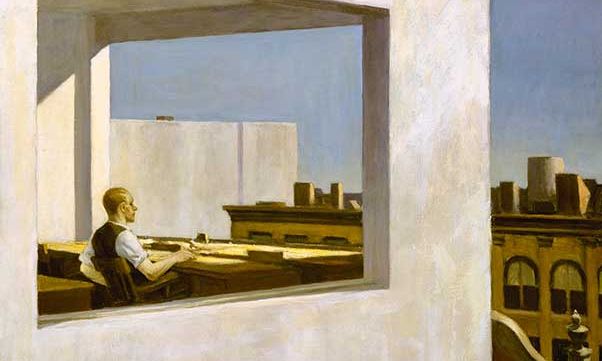“Like an eyrie right out of the Bauhaus”: Hopper’s Office in a Small City (1953)
© Heirs of Josephine N. Hopper/Licensed by Artists Rights Society (ARS), New York
Realism isn’t all it’s cracked up to be—if it exists at all. Even Edward Hopper—the 20th-century realist whose paintings of New York apartment houses, shop fronts and saloons divine a lonely-in-a-crowd experience of urban life with the veracity of lived experience—turns out to have been a fabulist.
That is one revelation of Edward Hopper’s New York, a biographical exhibition at the Whitney Museum of American Art (until 5 March), and which departs from a long-held party line to reveal an artist who painted the tranquil city he wanted to see rather than the teeming, filthy, noisy metropolis that its inhabitants observe every day. However, because the show arrived at a time when conspiracy theories are more credible to large numbers of people than factual evidence, it feels made for this moment.
Hopper is to the Whitney what Picasso is to the Museum of Modern Art: a big attraction. He remains popular even among New Yorkers, who seemed to outnumber tourists in galleries that I thought unusually crowded for a sleepy Monday afternoon. They appeared to be just as surprised as I was by curator Kim Konaty’s perceptive take on Hopper as a dreamer. “For Hopper,” she says, “the city existed in the mind as much as on map.”
Though he came from a suburb and was basically a native New Yorker, many paintings in this show represent an out-of-towner’s idea of the city, particularly Greenwich Village, where Hopper lived for most of his life as an artist. Reinforcing this impression were the many Hoppers that Konaty borrowed from museums in distant places, where postcard views of an alienating, menacing New York may ring truer than those in the Whitney’s deep reserves. Come to think of it, Nighthawks (1942), arguably Hopper’s most famous painting, resides in the Art Institute of Chicago.
His New York is not mine and never was. Except that it sort of is, and this was the biggest surprise of the show. Hopper took what he needed and left out the rest: the grit, the gridlock, the garbage and, most of all, the people. Their near total absence borders on the surreal, or it would, if the atmosphere didn’t so eerily replicate that of the 2020 pandemic shutdown. The more I saw of the show, the less dated Hopper became.
I live on an island where super-tall skyscrapers cast medieval shadows on streets packed with pedestrians who move to the rhythm of their DM pings without making eye contact, much the same as Hopper’s glum figures. Also, real people visibly age. Not so Hopper’s wife, Jo, his model for the solitary female figures that he depicted naked in front of windows, always younger than she was. (Hmm.)
In addition, Hopper’s cityscapes are flooded either with unobstructed sunlight or portray a neon-infused vacancy that permits no sense of movement. Contrast that with the LED conflagration of present-day Times Square and it begins to seem as if Hopper’s true specialty was still-life painting. His views from rooftops, upper floor windows or elevated trains put a lot of air between buildings that in reality allow none to pass. He was fond of water towers and chimneys, but tall buildings just got in the way of broad panoramas; in one canvas, all of Brooklyn is missing. Another, Office in a Small City (1953), looks like an eyrie right out of the Bauhaus.
Like any romantic, Hopper chased windmills. He campaigned against New York University’s (NYU) plan to redevelop a wide swath of his neighbourhood into classroom buildings and faculty residences. It was fascinating to read his correspondence with Robert Moses, the powerful unelected official who displaced hundreds of thousands of New Yorkers to build expressways that would speed them to parks and beaches. Yet Hopper managed to save The Row, his block of Federalist buildings on Washington Square, now part of NYU.
Though I didn’t know that history, NYU is my alma mater. As an undergraduate I joined a protest against the razing of several city blocks to make room for the Phillip Johnson-designed library that predictably put the south side of the park in deep shadow. What’s more, I lived directly in the path of a highway that Moses planned to run through the Village to the Hudson River. Its failure became his downfall, though Hopper did not live to know it. (He died in 1967.)
Rarely does a museum so effectively recalibrate the public’s understanding of a non-living artist. Over the last five years, the Whitney’s own formerly industrial neighbourhood has become the province of unaesthetic new high-rises so homogenised that it could be anywhere—except Hopper’s New York, a city of imagination that makes home feel at once familiar and alien.
It’s not that Hopper idealised Manhattan the way Woody Allen does, but rather reimagined it to suit himself. If only I could do that! On the other hand, what could be more relevant to New York than its constant rebuilding? Is reinvention not the city’s DNA? Are unanswerable questions not the soul of art?

